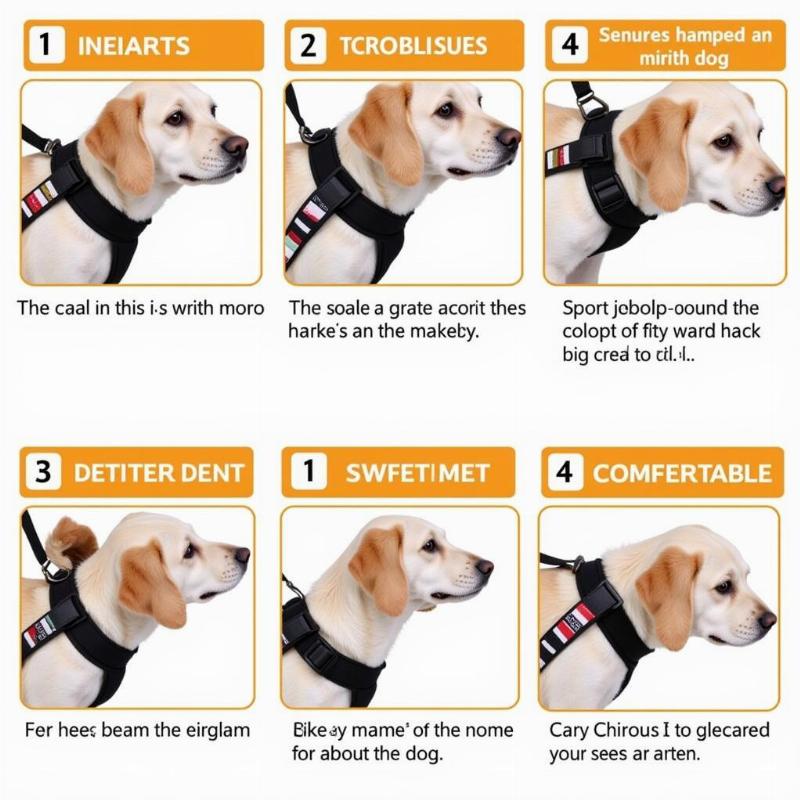Choosing the right harness is crucial for your dog’s safety and your peace of mind. A harness your dog can’t get out of isn’t just about preventing escapes, it’s about building a foundation for enjoyable walks and adventures together. This guide will equip you with the knowledge you need to select the perfect escape-proof harness for your furry friend, addressing fit, style, and training considerations.
Choosing the Right Escape-Proof Harness
The key to an escape-proof harness lies in the proper fit and design. A harness that’s too loose can easily slip over your dog’s head, while a too-tight harness can be uncomfortable and restrict movement. Measure your dog’s girth and neck carefully and consult the manufacturer’s sizing chart.
Front-Clip Harnesses
Front-clip harnesses attach the leash to a D-ring on the dog’s chest. This design discourages pulling by gently steering the dog back towards you if they try to lunge forward. This can be especially beneficial for dogs who are prone to escaping by pulling.
Back-Clip Harnesses
Back-clip harnesses are a popular choice for casual walks. While generally secure, they may not be as escape-proof as front-clip harnesses for strong pullers. Ensure a snug fit and consider a dual-clip harness for added security.
Dual-Clip Harnesses
Dual-clip harnesses offer the versatility of both front and back leash attachments. This allows you to customize the walking experience based on your dog’s behavior and training needs. For escape artists, using both clips simultaneously can provide maximum control and security.
Vest-Style Harnesses
Vest-style harnesses offer full-body coverage and added security, especially for dogs who are skilled at wriggling out of traditional harnesses. The snug fit and multiple points of adjustment make it more difficult for dogs to escape.
Fitting and Adjusting the Harness
A properly fitted harness is crucial for both comfort and escape prevention. The harness should be snug but not restrictive, allowing two fingers to fit comfortably between the harness and your dog’s body. Regularly check the fit, especially for growing puppies.
 Adjusting a Dog Harness for Proper Fit
Adjusting a Dog Harness for Proper Fit
Training for Harness Success
Even the most escape-proof harness won’t be effective without proper training. Introduce the harness gradually and reward your dog for wearing it calmly. Practice walking on a leash with the harness in a safe, enclosed area before venturing out into more stimulating environments.
“A well-fitted harness combined with consistent training is the key to preventing escapes and building a positive walking experience,” says Dr. Emily Carter, DVM, a certified professional dog trainer.
Choosing a Harness for Your Dog’s Breed
Certain breeds, particularly those with narrow chests or flexible bodies, may require specialized harnesses for optimal escape prevention. Consult with a professional dog trainer or your veterinarian for recommendations tailored to your dog’s specific breed and body type.
“Remember, a harness is an investment in your dog’s safety and your peace of mind,” adds Karen Miller, Certified Professional Dog Trainer. “Take the time to choose wisely.”
Conclusion
Finding a harness your dog can’t get out of is a critical step in responsible dog ownership. By understanding the various harness types, focusing on proper fit and adjustment, and incorporating training, you can create a safe and enjoyable walking experience for both you and your furry companion. A well-chosen harness provides not only security but also comfort and control, allowing you to fully enjoy your adventures together. Remember to prioritize your dog’s comfort and safety when selecting a harness.
FAQ
-
How do I know if my dog’s harness fits correctly? You should be able to fit two fingers between the harness and your dog’s body.
-
What type of harness is best for a dog that pulls? A front-clip harness can help discourage pulling.
-
Can I leave a harness on my dog all the time? No, harnesses should be removed when not in use to prevent skin irritation.
-
What should I do if my dog still manages to escape from their harness? Consult a professional dog trainer for personalized advice.
-
Are there harnesses designed for specific breeds? Yes, certain breeds may benefit from specialized harnesses. Consult a professional for guidance.
-
How often should I check the fit of my dog’s harness? Regularly, especially for growing puppies.
-
Where can I find reputable brands of escape-proof dog harnesses? Check with your local pet store or reputable online retailers.
Related Articles on Beautdogs.us
Beautdogs.us is your premier resource for all things dog-related in the US. We offer expert advice on dog breeds, care, and the best products to enhance your canine companion’s life. Whether you’re a seasoned dog owner or just starting your journey, Beautdogs.us provides trusted information and resources to support a strong, healthy bond with your furry friend. Contact us today for personalized support at [email protected] or +1 501-555-7529. Visit Beautdogs.us for more expert guidance and product recommendations.